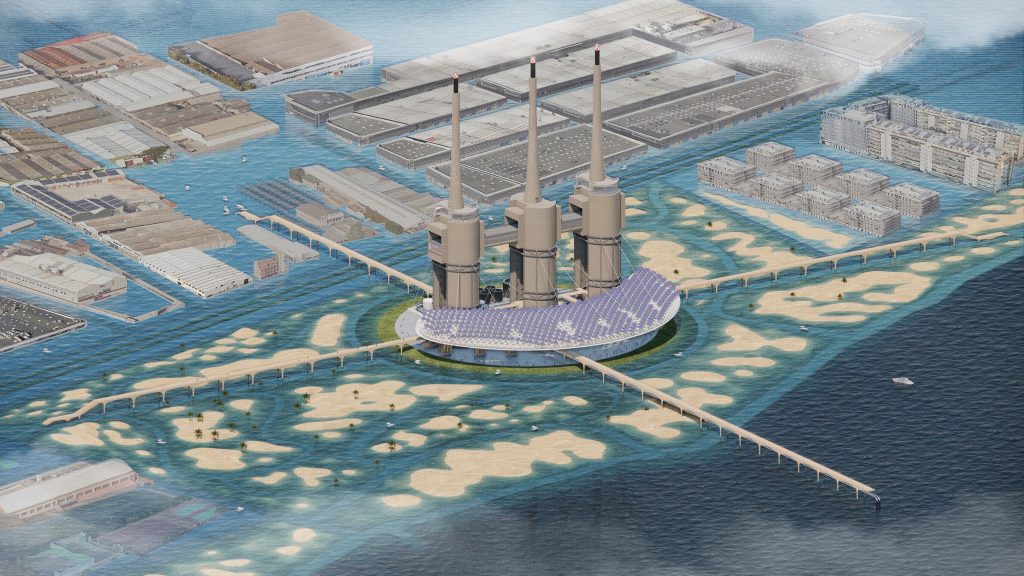The Power Oasis: Breathing New Life into Barcelona’s Industrial Heritage
A Botanical Sanctuary Amidst Climate Crisis
Can industrial relics become engines of ecological hope? That’s the central challenge tackled by Harry Haodong Wu in “The Power Oasis,” his thesis project completed as part of his Part II studies at the University of Westminster. Wu, whose résumé bridges two continents with work experience at London’s Burrell Foley Fischer and the delivery of projects in China, has poured his cross-cultural perspective and technical acumen into a proposal that pushes the limits of adaptive reuse in architecture.
Set in a not-so-distant future where Barcelona faces relentless drought and encroaching seas, “The Power Oasis” reimagines the city’s iconic Tres Xemeneies (Three Chimneys) as more than just a vestige of the past. Instead, Wu’s project transforms this post-industrial site into a hub for ecological innovation—a botanical garden powered by the sun, irrigated by desalinated seawater, and dedicated to preserving endangered native plant species. It is a bold attempt to merge architecture, science, and community in the face of climatic uncertainty.
Reinventing the Three Chimneys: Industrial Past, Green Future
The physical and symbolic center of Wu’s thesis is the Tres Xemeneies, a trio of soaring brick chimneys that once defined Barcelona’s energy infrastructure. Rather than erasing this industrial past, Wu leverages it—retaining the chimneys as monumental anchors while weaving in contemporary interventions. His design delicately balances historical preservation with forward-looking sustainability, a harmony that feels entirely fitting for Barcelona’s ever-evolving urban fabric.
The botanical garden at the project’s heart is more than a lush retreat: it acts as a testing ground for climate resilience. Wu’s intervention envelops the chimneys in a tapestry of vegetated walkways, solar arrays, and research modules. Elevated pathways snake through the site, offering both practical circulation and moments of contemplation amid resilient Mediterranean flora. The original brickwork is left visible, embraced by—rather than hidden behind—bio-climatic structures and greenhouses optimized for maximum solar exposure.
Engineering Resilience: Solar-Powered Desalination & Ecological Innovation
Confronting the challenges of drought and rising seas, Wu’s proposal is underpinned by robust climate engineering. Solar-powered desalination—an emerging but vital technology for Mediterranean water scarcity—takes center stage. Photovoltaic cells double as architectural shading, providing shelter while capturing the sun’s energy to purify seawater and feed the garden’s irrigation network. Tanks and reservoirs are deftly integrated into the landscaping, celebrating the process of water creation as an act of hope.
But “The Power Oasis” isn’t just about resource management. Wu envisions the site as a scientific and civic laboratory: a space where endangered native plants are collected, studied, and propagated in interactive research pods. These modules—accessible to the public as well as botanists—actively involve visitors in climate adaptation, transforming the visitor experience into one of discovery and stewardship. Data from plant trials, water usage, and renewable energy performance is displayed throughout, demystifying green technology for the community and amplifying public understanding.
A Civic Hub for a Changing Coastline
Where many climate-focussed proposals risk becoming sanctuaries for the few, Wu’s design places inclusivity and public engagement at its core. The garden spills into plazas, learning pavilions, and flexible event spaces designed to draw locals and tourists alike. Workshops, exhibitions, and citizen science initiatives create a lively calendar of activity, while shaded outdoor rooms cater to Barcelona’s cherished tradition of alfresco gathering.
Mindful of the altered coastline, the project introduces terraced landscapes that mitigate tidal surges, restoring a resilient buffer between city and sea. These landscapes double as living classrooms: children might roam among salt-tolerant planting, while researchers monitor evolving ecosystems. Wu’s approach highlights not only the urgency of adaptation, but also the joy and meaning to be found in collective action.
Recognition and Reflection
While still a thesis project, “The Power Oasis” has generated interest within academic circles for its deft interweaving of social, ecological, and infrastructural concerns. Wu’s ability to translate conceptual ambitions into sophisticated, site-responsive architecture is a testament to his two-and-a-half years of professional experience. His work reflects the ethos of the University of Westminster’s architecture program: urban, innovative, and always rooted in real-world challenges.
Wu’s cross-cultural background is evident in his project’s collaborative spirit—a balancing act of Western and Eastern design sensibilities, inflected with a pragmatism earned from both British conservationist practice and the dynamic urbanism of contemporary China. The result is a project that feels both global and uniquely Barcelonian.
Connect with Harry Haodong Wu
As Wu looks ahead to the next chapter of his career, he remains committed to forging new dialogues between architecture, ecology, and public life. “The Power Oasis” may be a speculative intervention for now, but its holistic ethos stands as a model for architects and students alike—a beacon for how we might transform heritage sites into agents of environmental and social renewal.
To learn more about Harry Haodong Wu’s work, connect with him directly:
- LinkedIn: Harry Haodong Wu
- Instagram: @hw_archi
- Email: haodongw3742@gmail.com
Whether you’re intrigued by his vision for urban resilience, interested in potential collaborations, or simply wish to follow his architectural journey, Wu’s blend of creativity and technical rigor offers much for the profession—and our cities—to aspire towards.











Add a comment